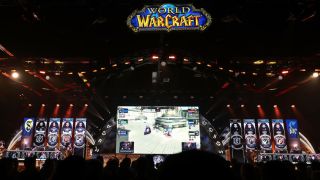The best game design schools, ranked by the Princeton Review 2024
Homework: Intellectual property & adaptation
Game design is world building. Even before massive sandbox-style games offered players vast environments to explore, even the simplest of worlds had characters, locations, and deep lore to be built from scratch.
Take Doom, the classic first-person shooter. Crude by today’s standards, Doom still had a world (you are on the moon, and later in hell), characters (you are a marine, they are demons) and rules (if the demons hit you enough times, you will die).
Fast forward and modern games feature worlds, characters and lore every bit as complex as any other entertainment medium, with success or failure likewise dependent on how compelling and creative they are.
With this in mind, it's perhaps surprising that games based on pre-existing, popular intellectual property aren't more successful, usually underperforming compared to games that rely on their own world-building.

Mighty brands from Star Wars to Lord of the Rings have all made attempts at adapting their universes to everything from first-person shooters, to real time strategy to massively multiplayer online role-playing games.
Many of these have been enjoyable games that have often, initially, sold extremely well (in fact, Hogwarts Legacy was the best-selling Playstation game of 2023), but in the vast majority of cases they quickly fall far behind the competition in terms of critical acclaim and, more importantly, active player counts.
For example, at the time of writing, no game based on major third party IP even breaks the top 20 MMOs in terms of active player count.
Consider why this may be, addressing the pros and cons facing a developer working with existing intellectual property.
Monetization & thinking outside the loot box
Once upon a time, gamers would walk into a shop and buy a box with a game disc in it. They'd take that game home and play it to completion. Developers would pocket the cash and make the next one. Maybe a sequel.
Those days are long gone. From monthly subscriptions, to regular DLC to controversial premium cosmetics and purchasable in-game currencies — modern developers' revenue streams are often as creative as the games themselves.
One Diablo Immortal player famously spent a staggering $100,000 on in-game upgrades. This led to an unforeseen consequence — he could no longer play the game's PVP mode as there were no comparable characters for him to fight.
It's an absurd, but instructive example of how in-game monetization can skew a game's balance. It also demonstrates how it's simply too lucrative a model for many studios to ignore.
One of the most common methods for creating revenue beyond the game's sticker price is also the most controversial: loot boxes.

Used in games as diverse as EA's FIFA series and Star Wars: Battlefront, loot boxes are designed to deliver a potent combination of randomized player progression alongside the kind of audio-visual dopamine hit you get from slot machines.
So a chorus of chimes would sound alongside a shower of sparks as it's revealed what you've got for your money, whether it be a double-ended lightsaber or Thierry Henry.
As such, loot boxes have come in for some heavy criticism (they're now removed from Star Wars games entirely) and their use is becoming increasingly subject to gambling regulation.
Studios' search for in-game revenue streams hasn't gone away however, and while random loot boxes are on the way out, it's a rare modern title that doesn't have some kind of in-game currency you can 'collect' with a swipe of your credit card.
The key question for developers then is — what exactly should players be able to do with their virtual bucks?
If wealthy players can buy too many advantages, or are even perceived as being able to do so, then your title can get hit with the dreaded 'Pay 2 Win' tag and players leave in droves.
But what exactly is 'Pay 2 Win'? Ask 100 gamers and you'll get 100 different answers, but any game where real-world cash can be used to obtain a gameplay advantage, particularly but not exclusively in a PVP or other multiplayer environment, risks being labeled Pay 2 Win.
Offering cosmetic rewards for purchase are one way to avoid this — things that are superficially desirable but don't provide a power boost.
Even cosmetics can cause controversy though. A player's avatar is a big part of their investment in the game. Outfits that can be earned without effort and skill will immediately lose a big part of their appeal.
Another lucrative option can be selling various forms of access. For example, early access to the finished version of a latest patch or expansion as part of a special edition.
Again though, this has to be carefully balanced to make sure that players coughing up the extra cash won't be at an advantage over the rest of the playerbase when they show up three days later.
Ongoing monetization isn't something modern developers can afford to ignore, but tread carefully. You also can't afford to charge for whatever makes your game unique.
Homework: Theorycrafting & player choice

It's a well-known axiom among game designers that, given the opportunity, players will remove all the fun from your game.
That sounds counter-intuitive, so let's unpack it a little.
The goal of every game is to successfully inspire desire. Whether that be to get to the top of the platform without the big gorilla hitting you with barrels, or to possess the most powerful magic sword of all time.
The point is to create something the player wants and then put obstacles in their path as they try to achieve it.
The problem is that people will, by nature, pick the most efficient method to reach their goals: the path of least resistance. In doing so, they may well end up ignoring all the fun you've so carefully crafted for them.
And, thanks to the internet and the power of crowdsourcing, even the tiniest fraction of advantage will be amplified to deafening levels, whether that be Twitch streamers detailing how OP their latest build is or exhaustive guides posted to your game's subreddit.
Take a recent patch in the world's biggest MMORPG, World of Warcraft.
Among the many, many systems for player progression was the process of getting friendly with a group called the Dream Wardens. You could eventually reach Renown Level 20 with this group, earning a powerful magic item.
It was technically possible to reach level 20 just days after the patch first came out. But the more enjoyable methods for doing so — mostly story-driven quests — would only reset on a daily or weekly basis, as the designers wanted players to take their time and enjoy the story. For most players, reaching level 20 through normal play would take many weeks. However, to achieve this milestone earlier than intended, players would have to grind out continuous, repetitive tasks. Many did exactly that.
Why? Well, a handful of cutting-edge guilds were demanding the item as a prerequisite for coveted group content spots, but more significantly it became a badge of honor in the community — a sign that you were a 'serious' player.
This is an extreme example, but it serves to illustrate the point. When offered a choice between fun and efficiency, many players will often sacrifice the former for the latter. In fact, it's something every player does to some degree or another.
Think about how you can design your in-game systems to offer meaningful progression choices without forcing the most determined of players onto a hamster wheel.
Live service gaming & the infinite narrative
With more and more games adopting the risky but potentially lucrative live service model, modern titles require an almost endless flow of content — new levels, new challenges, new zones to explore and new powers to acquire.
From simple update patches, to new DLC, and major expansions, all this new content requires games that are effectively infinitely scalable.
This can be challenging from both a systems and storytelling perspective, as designers need to carefully deliver increasingly powerful antagonists and constantly raised stakes to drive the progression of the title.
Let's examine how some of the industry's longest-running franchises deal with this issue.
The Total War franchise, with its unique mix of turn-based campaign play and RTS battlefield simulations, dates back to the year 2000, with the release of Shogun: Total War.
Initially the series had a simple, elegant solution to the infinite narrative problem, setting their succession of games in different historical eras, from the Napoleonic Wars to the Roman Empire.
Even this couldn't go on forever though, and in 2016 things changed when Creative Assembly acquired the rights to Games Workshop's Warhammer brand.
A superb example of the use of existing IP, the massive success of the game coincided with the growing popularity of the live service model.
Sequels were inevitable, and in-between them came a whole host of DLC packs with new characters, units and factions drawn from Games Workshop's extensive lore, itself dating back to the '70s.
Even with all this material at their fingertips, the success of Total War: Warhammer was by no means guaranteed. A controversial early decision was to make the franchise's key antagonists, the spiky Warriors of Chaos, only available to players as a DLC. You could fight Chaos in the base game, but you couldn't play as Chaos without buying the DLC.
This strategy would be refined across two sequels and innumerable DLC and character patches. The world map was not only expanded but more detail was added to existing areas. New factions came with their own unique economies and units, with existing factions being tuned as necessary to compensate.
Both chart-topping and critically acclaimed, TW:WH is still delivering a stream of new experiences for players.

The longest-running game narrative in history, World of Warcraft has experimented with a large number of systems over the years. These include the dynamics of character class interactions, the acquisition and selection of new abilities, ways to earn player power, new cosmetics to collect, and a variety of quests and missions. The game has been through many changes, but with a few exceptions — the ‘Empowered Spells’ available to the new Dracthyr Evokers, for example — the core combat mechanics of movement and targeting have remained the same. Ultimately, with a two-decade legacy, there's only so much the core gameplay can be changed without a lot of redevelopment. And there are strong arguments for not doing so, especially when it remains the most popular MMO in the world.
However, building on Blizzard's own IP, developers enjoyed completely free rein when it came to story, and were able to constantly raise the narrative stakes from its inception in 2004 to the game's current iteration.
Player characters that had begun their careers rescuing cats from trees and fighting bandits quickly graduated to battling dragons, then demons, then bigger demons, then the demons that were in charge of the demons they fought the last time.
WoW players saved the cat, then the village, then the city, then the world, then the galaxy, then the universe and then... what?
The critically and commercially mauled 'Shadowlands' expansion tried to solve this problem by pitting the players against the very concept of death itself, but this wasn't enough to stave off antagonist fatigue and active player numbers dropped substantially.
Whether your choice is more systems, more story, or something else entirely, live service is a challenge for every member of a design team.
The biggest gaming news, reviews and hardware deals
Keep up to date with the most important stories and the best deals, as picked by the PC Gamer team.
